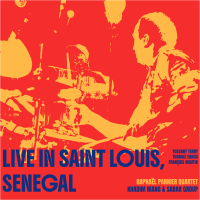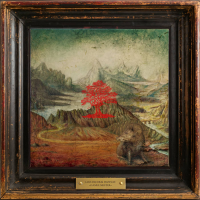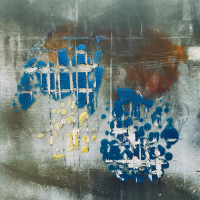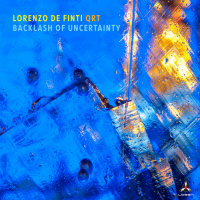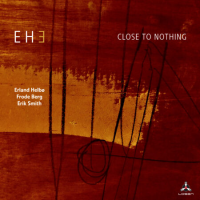Home » Jazz Articles » Extended Analysis » The Band: The Band: A Musical History
The Band: The Band: A Musical History
 The Band
The Band A Musical History
Capitol/EMI
2005
A Musical History is at once as unassuming and all-encompassing as the name of the group it anthologizes, The Band. With each successive compilation devoted to the group, beginning with the two-CD set To Kingdom Come (subtitled definitive), then the three disc package Across the Great Divide, more detail appears in the story before during and after the group assumed their given name (from the informality of their presence in Woodstock New York community within which they woodshedded before their move the West Coast).
Since Robbie Robertson, the titular leader of the group, oversaw the former and had more than a little to do with the latter, not to mention expanded remasters of the individual albums that came out early in this new millennium, it comes as little surprise that he supervises this magnum opus. But credit where credit is due, to multi-instrumentalist Garth Hudson, from whose archives comes much of the unreleased material included on this five-CD plus DVD package.
The linear approach of this collection does much to clarify the development (as well as the intermittent stagnation) of the quintet, beginning with the Band's roots in Canada as the barnstorming likes of sidemen to Ronnie Hawkins, to the melodramatic closure to their performing days in the form of The Last Waltz. instead of beginning at the start and moving chronologically, go right near the end of CD5 and listen to two of the most memorable and worthwhile unreleased items in the package. If Capitol were to release a single from A Musical History, "Home Cookin' and "Out of the Blue would be the perfect double-sided item.
The former is a paean to the warmth and intimacy of family at various stages of life, Rick Danko's inimitable vocal ache carrying all the wistful sentiment a human voice can manage, while the musical accompaniment sounds like the soundtrack to a Mark Twin short story. Likewise, to a slightly lesser extent, the latter: sung by guitarist/composer Robbie Robertson( ostensibly because Richard Manuel was nowhere to be found), it's an illustration of how the late pianist/vocalist/drummer was the ideal voice for Robertson's songs. As Robbie uses a quavering falsetto that calls to mind Manuel's most vibrant performances, you hear the echo of The Band's time together from beginning to end.
A microcosm as such, it doesn't displace a more through investigation of A Musical History, but only give you a starting point from which to peruse it. It's half-dozen discs enclosed in a hard-cover cloth binding measuring 10.5 by 12 inches, the package would serve well as textbook for a course in history which is of course what it is intended to be, covering as it does, the evolution of The Band into an increasingly mythological entity by dint of heir associations as well as their own accomplishments.
Essayist Rob Bowman's liner notes are weighty with detail and although he tends to overstatement at times, he manages to illustrate the modus operandi of the band in such a way we can better understand how their achievements great and small came to be. Note for instance how Allen Toussaint's original horns charts for Rock of Ages were in a different key than the group usually played and how they astutely adjusted (then recall how in his review of the album, upon its release, Ralph J Gleason commented on how The Band slowed down their playing!).
Pay special attention to the repeated references to how the group switched instruments—and not just keyboardist/saxman Garth Hudson. Manuel often went from the percussion instrument that is piano to drums, while Danko played fiddle ("Rag Mama Rag ) and Levon Helm could handle mandolin("Ain't No More Cane on The Brazos ) and electric guitar ("Strawberry Wine ). live) as well as drums; this versatility lent much of character to the Band's instinctive interaction as a unit as the inherent approach to a melody instrument carried over to a rhythm piece.
Many of the photographs included in the package are previously unpublished(officially anyway), like the music itself, to the extent you wish more pages of pictures were inserted either by themselves oras illustrations to the various chapters covered; it's only then you realize that archiving aswe know it now was only in it formative stages in the mid to late-Sixties and Seventies, hence the surprising discovery of video from the Academy of Music run (included as one of eight performances on the DVD), that you rue the absence of more documentation of that event, The Band's 1974 tour with Bob Dylan, plus various other significant events in the group's history including Watkins Glen.
Perhaps as a means of not taking unnecessarily proprietary ownership of the project or the group itself, it's noteworthy that the lyrics to the various songs, most of which are Robertson's, are not included in A Musical History. Even if it were only of the "official" studio recordings themselves, how much more complete would this set be with the often cryptic but virtually always provocative words to scan? The absence of that material also prompts the thought of a similarly exhaustive campaign devoted to The Band's works with Dylan in the form of The Basement Tapes and the live recordings of their reunion tour.
But all this comes second to the music included here and a treasure trove it is, reminder if you needed one, of how soulful and earthy the group's best music is and what a extensive spiritual quotient it includes. Little wonder their roots extend so deeply into the Southern blues and the mystical likes of New Orleans. Disc one is a terrific compilation in and of itself, suggesting even at this early juncture the influence of the group—did Clapton cover "Further on up the Road in the Seventies after having heard the Hawks?—as well as the prominence of Richard Manuel; as his recession into the background becomes conspicuous, especially in terms of songwriting, the dynamics of the Band changed, making them more conventional though perhaps not much less distinctive on their own terms.
While much of the unreleased material consists of what are termed "song sketches," usually identified as demos in less pretentious terms, the inclusion of alternate takes such as "Ferdinand the Imposter form Music From Big Pink mystifies since the expanded versions of The Band's original albums already contained them; the logic as applied here may only extend to ensure the cd's contained as much content as possible, certainly a laudable intent if only from a consumer point of view. And since the remastered CDs function more like snapshots rather than fluid cinema---which is really what the story of The Band brings to mind, Robertson's infatuation with film notwithstanding, —hearing Danko sing an early version of "Twilight, a song that in finished form never made an album, magnifies the collective creativity of The Band which is at the core of their reputation.
It's a measure of how highly evolved these men were as musicians that such preparatory recordings were and are superior to much of what was popular at the time. It's difficult ifnot impossible to understand how far outside of the mainstream were The Band when theyf irst emerged under that name until you watch the live performances included on the DVD. (Which as a surprise includes some audio tracks, noted in the disc menu but unlisted in the credits[which may require some technical configuration of your equipment to hear.)
The Band's maturity and camaraderie are unquestionable on the three Saturday Night Live takes(again notable for Manuel's reading of "Georgia on My Mind) And the joy of rediscovering their music is palpable on the Rock of Ages/Academy of Music "Don't Do It : like the performances from 1970's Festival Express, early in the concert career of The Band proper, where the spontaneous intricacy is simply dazzling, the all too careful approach they take in the stadium setting of Wembley Arena is indicative of the shortfalls of The Band live: with no theatrical bent to speak of, their reserved demeanor could fail to connect with any audience, thereby rendering stiff their own interaction.
Yet the transcendent joy to be heard when they play as on 1976's "Forbidden Fruit is to experience what the pleasure of live music is all about. The album of covers, Moondog Matinee, is often perceived a comparatively slight work in The Band's oeuvre, but how significant might it have been had the group taken the exhuming of roots material as a means of reviving their interest in playing live? It might well have allowed them an avenue to educate their audience as well as themselves as musicians by complementing their original material.
Likewise the various collaborations with Bob Dylan, whose presence runs through this anthology like a contextual theme. The Band were as different when they played with the bard as he was when he played with them, a chemistry as evident on the excerpts form a Tribute to Woody Guthrie concert in 1968, as the studio recordings of "Can You Please Crawl Out Your Window and the concert cuts from 1966 ("Just Like Tom Thumb's Blues, available nowhere else either artist's discography) and the reunion tour of 1974. Comprehensive and complete as it purports to be, the best music on A Musical History will move novices to delve deeply into the artist's individual discography for detailed inspection of that work. Were it not for the ornate staging of The Last Waltz, the Band's final studio recordings are a reminder of how their material lost its enigmatic mysticism when Robertson became self-conscious and began trading aphorisms for symbology(a process actually begun as far back as the group's second album).
What's unforgettable is how, even on the near-pedestrian likes of "The Saga of Pepote Rouge, The Band were aiming higher than virtually all their peers, not to mention those artists [sic] inhabiting the mainstream at that moment. It's to certify the timelessness of their work to collect it in a package like A Musical History because it is worth keeping for a lifetime.
Visit The Band on the web.
Tracks: CD1: Who Do You Love?; You Know I Love You; Further on Up the Road; Nineteen Years Old; Honky Tonk; Bacon Fat; Robbie's Blues; Leave Me Alone; Uh Uh Uh; He Don't Love You (And He'll Break Your Heart); (I Want to Be) The Rainmaker; The Stones I Throw The Stones I Throw (Will Free All Men); Go Go Liza Jane; Can You Please Crawl Out Your Window?; Tell Me, Momma; Just Like Tom Thumb's Blues; Words and Numbers; You Don't Come Through; Beautiful Thing; Caledonia Mission; Odds and Ends; Ferdinand the Imposter; Ruben Remus; Will the Circle Be Unbroken.
CD2: Katie's Been Gone; Ain't No More Cane on the Brazos; Don't Ya Tell Henry; Tears of Rage; To Kingdom Come ; In a Station; The Weight; Long Black Veil; Chest Fever;Lonesome Suzie; This Wheel's on Fire; I Shall Be Released; Yazoo Street Scandal; I Ain't Got No Home Orange Juice Blues (Blues for Breakfast); Baby Lou; Long Distance Operator; Key to the Highway; Bessie Smith.
CD3: Across the Great Divide; Rag Mama Rag; The Night They Drove Old Dixie Down When You Awake; Up on Cripple Creek; Whispering Pines; King Harvest (Has Surely Come) Get Up Jake; Jemima Surrender ; Daniel and the Sacred Harp; Time to Kill; All la Glory The Shape I'm In; Stage Fright; The Rumor; Slippin' & Slidin'; Don't Do It; Strawberry Wine Rockin' Chair; Look Out Cleveland; 4% Pantomime.
CD4: Life Is a Carnival; When I Paint My Masterpiece; The Moon Struck One; The River Hymn; Don't Do It ; Caledonia Mission ; Smoke Signal ; Unfaithful Servant ; The W.S. Walcott Medicine Show ; The Genetic Method. Chest Fever; (I Don't Want to Hang Up My) Rock 'N' Roll Shoes; Loving You (Is Sweeter Than Ever); Endless Highway; Move Me ; Two Piano Song; Mystery Train.
CD5: Ain't Got No Home; Share Your Love with Me; Didn't It Rain; Forever Young; Rainy Day Women #12 & 35; Highway 61 Revisited; Ophelia; Acadian Driftwood; It Makes No Difference; Twilight; Christmas Must Be Tonight The Saga of Pepote Rouge; Livin' in a Dream; Forbidden Fruit; Home Cookin'; Out of the Blue; Evangeline; The Night They Drove Old Dixie Down; The Weight
CD6/DVD: Long Black Veil; Rockin' Chair; Don't Do It; Hard Times (The Slop)/Just Another Whistle Stop; The Genetic Method/Chest Fever; Life Is a Carnival; Stage Fright; Georgia on My Mind.
Personnel: Rick Danko: bass, fiddle, lead and background vocals; Levon Helm: drums, lead and background vocals, mandolin, electric guitar; Garth Hudson: keyboards and saxophones; Richard Manuel: piano, lead and background vocals, drums; Robbie Robertson: guitar, lead and background vocals, piano.
Personnel
The Band
band / ensemble / orchestraAlbum information
Title: The Band: A Musical History | Year Released: 2005 | Record Label: Capitol Records
Tags
About The Band
Instrument: Band / ensemble / orchestra
PREVIOUS / NEXT
Support All About Jazz
 All About Jazz has been a pillar of jazz since 1995, championing it as an art form and, more importantly, supporting the musicians who make it. Our enduring commitment has made "AAJ" one of the most culturally important websites of its kind, read by hundreds of thousands of fans, musicians and industry figures every month.
All About Jazz has been a pillar of jazz since 1995, championing it as an art form and, more importantly, supporting the musicians who make it. Our enduring commitment has made "AAJ" one of the most culturally important websites of its kind, read by hundreds of thousands of fans, musicians and industry figures every month.









